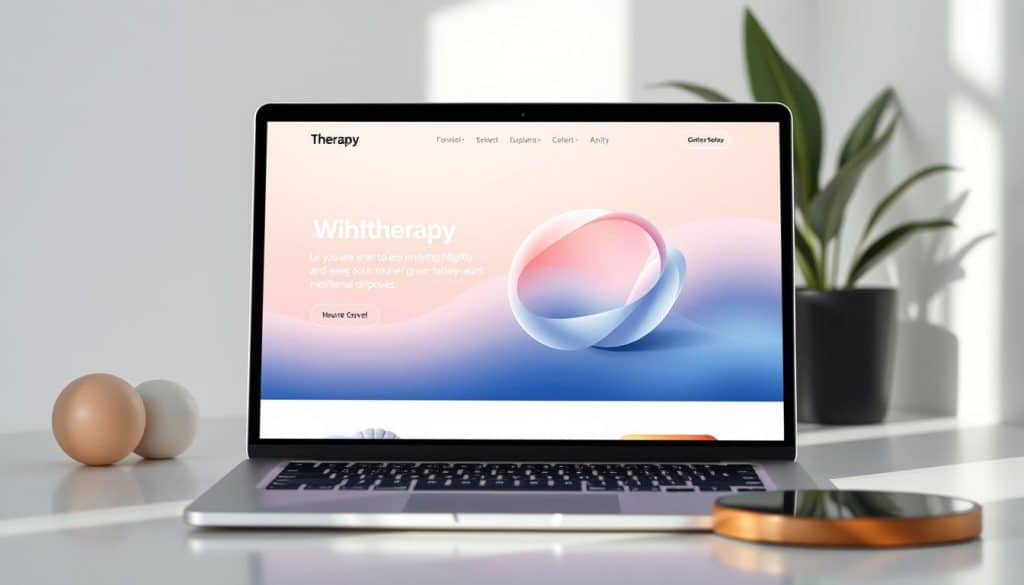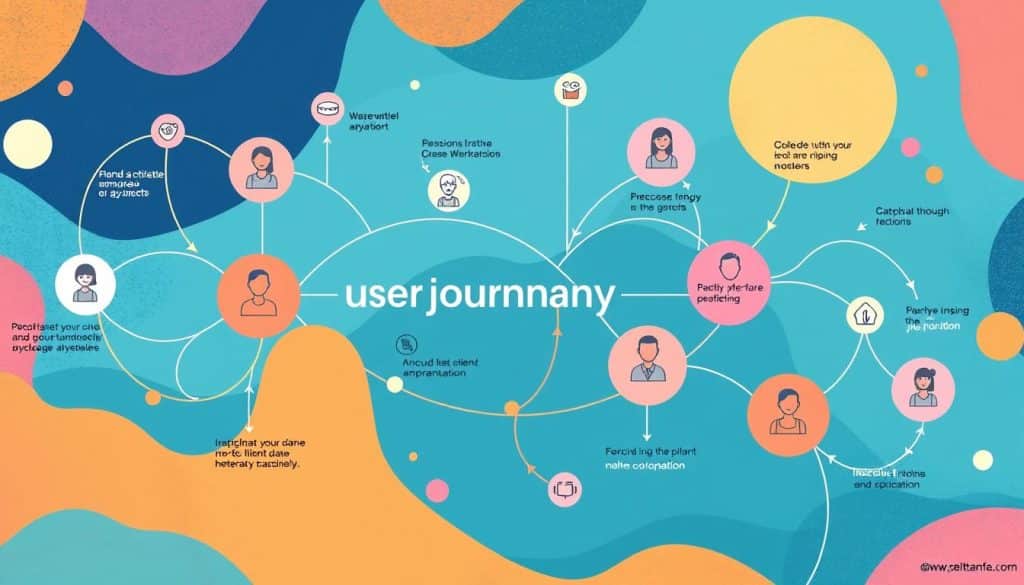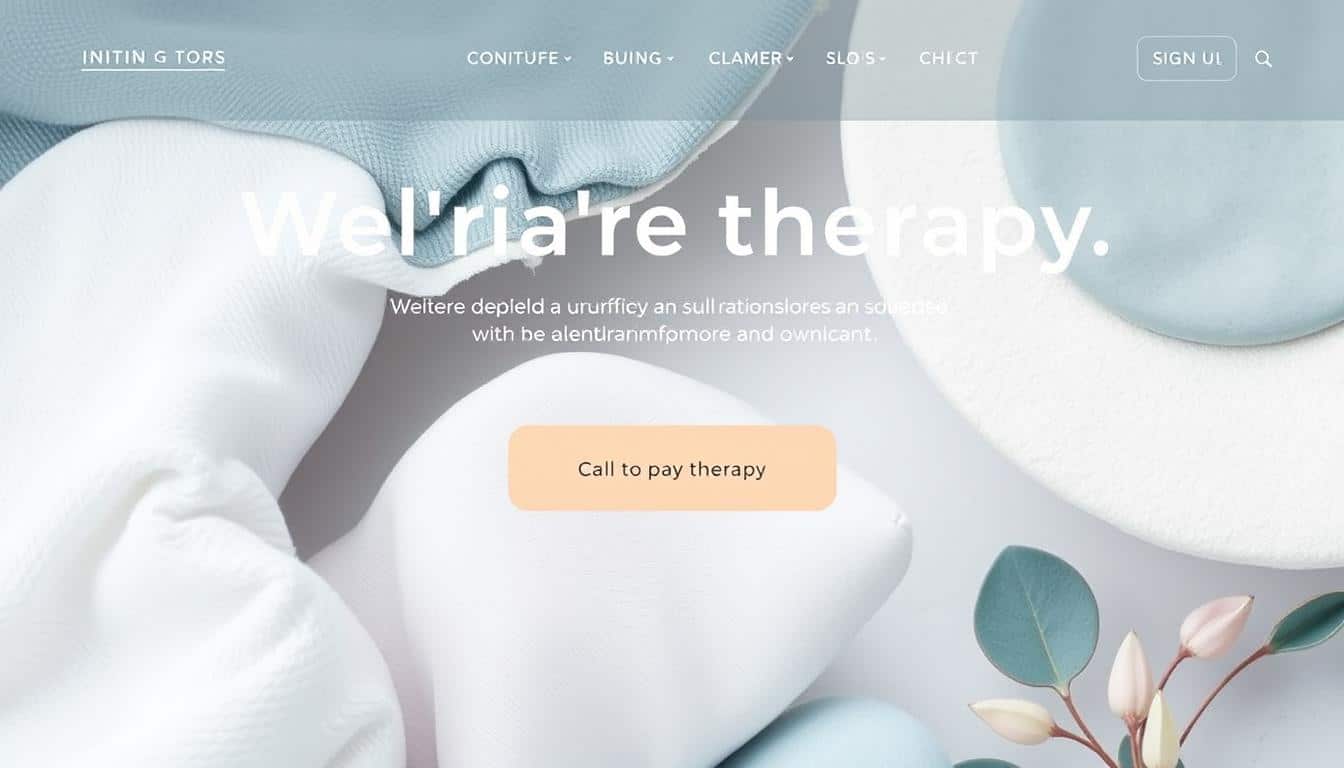Creating a captivating and user-friendly therapy website is key in today’s digital world. Your online presence shows who you are and what you offer. It’s important to make sure it meets your audience’s needs and stands out.
In this article, we’ll share practical tips to improve your website’s user experience. This will help you build trust, engage with your audience, and increase conversions.
Key Takeaways
- Understand the unique needs and pain points of your therapy clients to deliver a tailored user experience.
- Implement usability testing to identify and address usability issues, ensuring your website is easy to navigate and use.
- Optimize your user interaction design, including intuitive information architecture and seamless navigation, to create an engaging experience.
- Ensure your website is accessible to users with diverse abilities, promoting inclusivity and reaching a wider audience.
- Utilize user journey mapping and user research to gain valuable insights and continuously enhance your website’s performance.
- Adopt a responsive design approach to provide a seamless experience across various devices and screen sizes.
- Develop a comprehensive content strategy to effectively communicate your expertise and build trust with your clients.
The Importance of User Experience for Therapy Websites
Your therapy website is like a digital face of your practice. It’s key to connect with clients and build trust. This part talks about how to make your website better for users by understanding their needs and showing credibility.
Understanding the Unique Needs of Your Clients
People looking for therapy face big emotional and mental health challenges. Your website should show empathy and understand the trust needed in therapy. Dreem Therapy says it’s vital to create a safe online space for clients to start their journey.
Knowing what your clients need helps you design a better website. You can make it easy for them to find what they need. This makes the therapy website user experience better.
Building Trust and Credibility Online
Your website is often the first thing people see when they look for therapy. It’s important to show trust and credibility. Clients want to feel sure about the mental health professionals they choose.
Things like good design, following HIPAA rules, and showing your skills online help build trust. These efforts make your website safe and reliable. This helps clients feel better about their experience with you.
Usability Testing: Optimizing Your Site for Ease of Use
Your website is a key way to connect with potential clients. To make sure it’s easy to use, doing usability testing is key. This lets you see how users interact with your site and find ways to make it better.
To do good usability testing, start by knowing who your site is for. Then, find people who match your target audience to test your site. Watch how they use your site and note any problems they have.
Look closely at how users interact with your information architecture and user interaction design. See if they can find what they need easily. Make sure your site’s features and design meet their needs. This feedback helps you make your site better for users.
Usability testing is something you should keep doing. It helps your site stay good for your clients over time. By focusing on usability testing, you make a website that people trust and enjoy using.
| Key Usability Testing Metrics | Description |
|---|---|
| Task Success Rate | The percentage of users who were able to complete a given task successfully. |
| Time on Task | The average time it takes users to complete a specific task. |
| Error Rate | The number of errors or mistakes made by users during task completion. |
| User Satisfaction | The level of satisfaction users express with their overall experience on the website. |
By watching these metrics, you can find ways to make your site better. This helps keep your therapy website easy and enjoyable for everyone.
User Interaction Design: Creating Intuitive Interfaces
Creating an intuitive user interface is key for your therapy website. By focusing on user interaction design and information architecture, you help clients navigate easily. This makes it simple for them to find what they need.
Navigation and Information Architecture
A good website navigation system is essential. Organize your content in a way that makes sense. Use clear labels that meet your clients’ needs.
Make your menu system attractive and easy to use. Add search functions that help visitors find what they’re looking for fast.
Information architecture is also important. Organize your content in a way that matches your clients’ expectations. Use clear structures and links to help them navigate your site.
“The true sign of intelligence is not knowledge but imagination.” – Albert Einstein
By focusing on user interaction design and information architecture, you make your website both beautiful and useful. Always listen to feedback and improve your design. This will build trust and strengthen your online presence.

Accessibility: Ensuring an Inclusive Experience
Accessibility is key in therapy websites. It’s not just about looks; it’s about making sure everyone can use your site. By focusing on accessibility, you make your website welcoming to all.
Optimizing for screen readers is important. This means organizing your content well and using clear headings. It helps everyone, especially those with visual issues, and makes your site better.
Also, adding closed captions and transcripts is vital for those who are deaf or hard of hearing. This shows you care about accessibility and builds trust with your visitors.
Color contrast is another big deal. Making sure text and backgrounds have enough contrast helps those with vision problems. It makes your site easier to read for everyone.
Using responsive design makes your site better for everyone. It works well on all devices, from phones to computers. This means more people can use your site, no matter where they are.
By focusing on these accessibility points, you make your website a place where everyone feels welcome. This lets all your clients easily and confidently use your therapy services.
Therapy Website User Experience: A Holistic Approach
Creating a great therapy website user experience means looking at everything. This includes user research and content strategy. It shows how important it is to see your website as a whole. This way, you can make a site that is both useful and enjoyable for your clients.
User journey mapping is key to this approach. It helps you understand what your clients need and want when they visit your site. By studying how they interact with your site, you can make it easier and more personal for them.
Also, user research is vital. It gives you insights into what your audience likes and expects. With this information, you can make your website better. It will meet your clients’ needs and make them feel understood.
A good approach also means having a content strategy that fits your clients’ needs. By creating content that is helpful and easy to read, you can build trust. You can also show your expertise and help your clients on their journey to better mental health.
In the end, a user-focused approach to designing your therapy website is crucial. It helps create a great online experience. This experience will keep your clients engaged and happy. By focusing on what your clients need, you can make your website a powerful tool for helping them.
User Journey Mapping: Enhancing the Client’s Path
Creating a smooth user experience on your therapy website is key today. User journey mapping is a powerful tool to make this happen. It helps you understand your clients’ actions, needs, and challenges. This way, you can make your website more user-friendly and guide them smoothly through it.
Understanding User Behavior and Pain Points
User journey mapping shows how your clients move through your website. It highlights any hurdles, frustrations, and chances to get better. By looking at user behavior and pain points, you can make smarter design choices. This improves the user journey for everyone.
To make a great user journey map, focus on these important points:
- Know your client personas and their specific needs, goals, and challenges.
- Outline the usual steps a client takes, from first learning about you to booking or finding resources.
- Study the emotions and possible obstacles your clients might face at each step.
- Find ways to make the user experience smoother and more helpful for your clients.
By using user journey mapping, you can really get to know your clients’ behaviors and challenges. This knowledge lets you improve your therapy website’s user experience.

“Understanding your clients’ behaviors and pain points is the key to creating a seamless user experience that keeps them coming back.”
User Research: Gaining Valuable Insights
Understanding your therapy website’s audience is key. You need to know their needs and pain points. By using quantitative data and qualitative data, you can improve their experience.
Quantitative Data Collection
Website analytics and user surveys give you numbers. They show how users behave and what they like. This helps you see where to improve and how to keep users engaged.
Qualitative Data Collection
User interviews and usability tests give you a deeper look. They reveal how users feel and think. This helps you design a website that truly meets their needs.
Using both quantitative data and qualitative data helps you understand your users well. This way, you can make your website better for them.
| Data Collection Method | Insights Gained |
|---|---|
| Website Analytics | User behavior, engagement metrics, and performance optimization |
| User Surveys | User preferences, pain points, and satisfaction levels |
| User Interviews | Emotional responses, thought processes, and in-depth user needs |
| Usability Testing | Identification of usability issues and opportunities for improvement |
“The key to creating a user-centric website lies in understanding your audience through comprehensive user research.”
Responsive Design: Adapting to Different Devices
In today’s world, mobile devices are everywhere. Making sure your therapy website works well on all screens is crucial. Responsive design helps create a great user experience on phones, tablets, and computers.
Responsive design is more than just making content fit different screens. It’s about making a website that looks good and works well on all devices. This ensures your website is easy to use and fun for everyone.
When designing a responsive website, think about content order, layout, fonts, and interactive parts. A good responsive website changes smoothly, giving users a consistent and fun experience, no matter their device.
“Responsive design is not just about making a website look good on different devices; it’s about creating an exceptional user experience that caters to the unique needs of your clients.”
Responsive design makes your website easy to use and accessible. This strengthens your online presence and helps you connect better with your clients.
Conclusion
Improving your therapy website’s user experience is a smart move. It can boost client engagement, trust, and conversions. Focus on making your site easy to use, accessible, and well-designed. This will help you connect with your audience better.
Creating a top-notch therapy website is key to a strong online presence. It helps you connect with your clients. A good user experience builds trust and keeps clients coming back. This is vital for your practice’s success.
Understanding your clients’ needs is essential for a great therapy website. Do thorough research on what they want and need. Design your site to be easy to use and informative. This way, you inspire and empower your clients to get the care they need.



